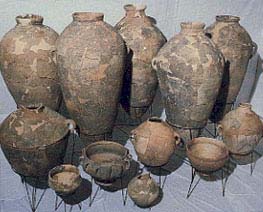Image Details

Courtesy Israel Finkelstein
Collared-rim storage jars. The Israelite settlement of the relatively dry hill country of Manasseh required a means of storing water. William F. Albright suggested that water cisterns served this need, but subsequent excavations failed to find cisterns at most Iron Age I sites. On the other hand, the collared-rim pithos, or storage jar—the tall vessels at the rear of this group of Iron I pottery—is one of the most common features of Iron I sites, constituting about 30 percent of the total pottery inventory. Decorated with a collar-like ridge at the top of its short wide neck, this type of storage jar generally has a capacity of 10 to 15 gallons. Zertal believes that the collared-rim pithos was the principal means of water transport and storage during the early Israelite settlement of the hill country. Its disappearance during the United Monarchy (beginning about 1000 B.C.E.) supports this idea; at that time, the iron tools used to dig cisterns became more common, and water cisterns dug in bedrock with iron tools replaced the collared-rim pithos.
